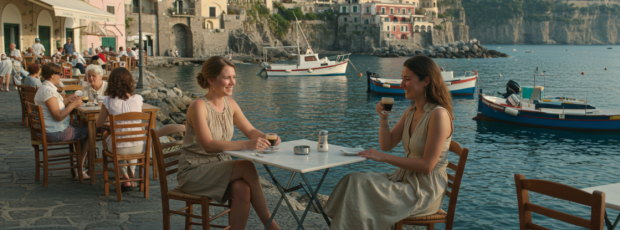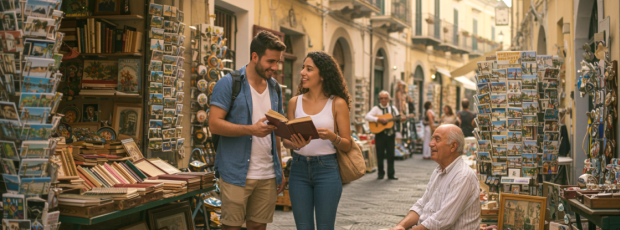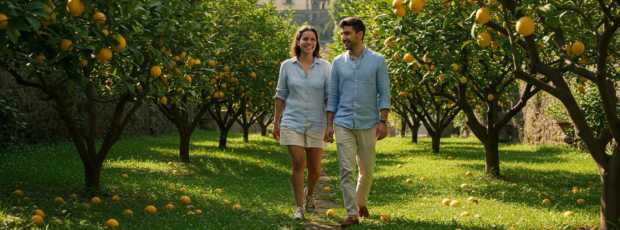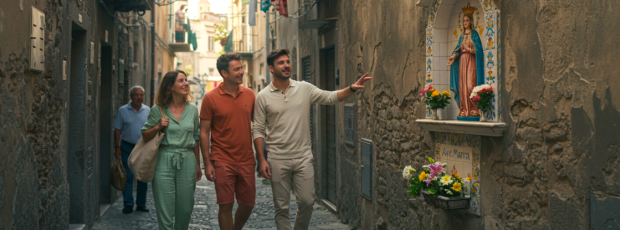Table Of Contents
- Where Do Celebrities Actually Stay in Sorrento?
- What's the Real Story Behind Sorrento's Ancient Lemon Groves?
- How Can You Experience Sorrento Like a Local Artist?
- What Secret Swimming Spots Do Locals Actually Use?
- Where Can You Find the Best Sunset Views Without Crowds?
- How Do You Experience Sorrento's Food Scene Beyond Tourist Restaurants?
- What Hidden Cultural Experiences Are Most Visitors Missing?
- Where Can You Find Authentic Shopping Experiences?
- What Are the Best Day Trip Extensions from Sorrento?
- How Can You Experience Sorrento's Nightlife Like a Local?
- What Makes Sorrento Different from Other Amalfi Coast Towns?
- Where Are the Most Photogenic Spots Tourists Don't Know About?
- How Do You Navigate Sorrento's Seasonal Rhythms?
- What Are the Best Ways to Connect with Local Communities?
- Where Can You Find the Most Romantic Experiences in Sorrento?
- What Transportation Secrets Make Exploring Easier?
- How Can You Avoid Common Tourist Mistakes?
- What Are the Best Hotels for Different Types of Travelers?
- How Do You Plan an Unforgettable Weekend in Sorrento?
- What Local Festivals and Events Should You Know About?
- Where Can You Experience Traditional Crafts and Artisans?
- What Are the Hidden Culinary Traditions Worth Discovering?
- How Can You Contribute Positively to Local Communities?
- What Makes Sorrento Special for Different Types of Travelers?
- Conclusion: Why Sorrento Continues to Surprise Me
When visitors ask me about unusual things to do in Sorrento, I smile because they're usually expecting the typical tourist checklist. Instead, I lead them down narrow stone steps to hidden natural pools, through my grandmother's favorite lemon grove, and into studios where artisans still hand-paint ceramics using techniques passed down for generations.
Living in Sorrento Italy means I've discovered corners of this coastal gem that even longtime residents sometimes overlook. While most tourists flock to Piazza Tasso and the obvious viewpoints, I've spent years uncovering the secret spots that make the Amalfi Coast truly magical.
The beauty of Sorrento offers so much more than postcard views. It's in the fisherman who still mends nets at dawn in Marina Grande, the elderly woman who makes fresh pasta behind an unmarked door on Corso Italia, and the natural swimming holes that locals have guarded like family secrets for decades.
Where Do Celebrities Actually Stay in Sorrento?
Everyone wants to know where the famous faces rest their heads when they visit Sorrento. The answer isn't what you'd expect from typical souvenir shops chatter.
While boutique hotels like the Belmond Grand Hotel Excelsior Vittoria grab headlines, I've spotted celebrities in much more unexpected places. Last summer, I watched a Hollywood actor sip limoncello at a tiny family-run bar in Piano di Sorrento, completely unbothered by the lack of paparazzi.
The real celebrity secret isn't about five-star amenities, it's about authenticity. Many choose smaller properties tucked away from the main tourist routes, places where they can experience daily life without the crowds that descend on Piazza Tasso during peak season.
I once shared an elevator with a famous Italian actress at a restored Roman villa that operates as a discreet retreat. She told me she comes here specifically because it feels like staying at a friend's house, not a hotel. These hidden gems offer something money can't buy elsewhere: genuine connection to the sorrentine peninsula's soul.
What's the Real Story Behind Sorrento's Ancient Lemon Groves?
Walking through a lemon grove at sunrise changes everything you think you know about Sorrento lemons. The tourist train doesn't stop here, and most day trippers never venture beyond the manicured gardens near the historic centre.
My friend Giuseppe has been cultivating lemons on the same terraced hillside for forty years. He taught me that Sorrento's lemons aren't just larger than others, they're grown in volcanic soil that gives them a unique sweetness that makes the difference between good and extraordinary limoncello.
The incredible panoramic views from these groves reveal layers of history most visitors miss. You can trace ancient Roman paths, spot remnants of medieval watchtowers, and understand why this stretch of the south coast became so prized by emperors and artists alike.
Giuseppe makes his own limoncello spritz using a recipe his grandmother whispered to him. Sitting on his terrace, watching the sun paint Mount Vesuvius in the distance, I understood why people have been drawn to these groves for centuries. It's not just about the lemons, it's about the stories they hold.
Looking for a private city experience in Sorrento?
Explore the city with a local who plans a private day just for you; no groups, no scripts.
How Can You Experience Sorrento Like a Local Artist?
The ceramic studios tucked into Sorrento's old town aren't just shops, they're living museums where tradition meets creativity. Most tourists walk past these workshops without realizing they're missing the heart of local culture.
I spend Tuesday afternoons in Marco's studio, a cramped space behind San Francesco where he creates pieces that capture the essence of the Amalfi Coast. His hands move with practiced precision, painting lemon motifs that somehow feel both ancient and contemporary.
Marco offers cooking classes that go far beyond typical tourist experiences. We prepare gnocchi alla sorrentina using tomatoes from his family's garden, finishing with a rich tomato sauce that's been passed down through four generations. The beautiful frescoes on his studio walls tell stories of Sorrento's patron saint, creating atmosphere that transforms simple cooking into cultural immersion.
The real magic happens when Marco shares his techniques for capturing natural light in ceramics. He explains how the angle of Mediterranean sun at different times of day influences color choices, connecting his art to the stunning views that surround us.
What Secret Swimming Spots Do Locals Actually Use?
Forget the crowded beach clubs, Sorrento's most enchanting swimming happens in hidden natural pools that require a bit of adventure to reach.
Bagni Regina Giovanna isn't exactly secret anymore, but most visitors don't know about the smaller pools accessible only at low tide. I discovered these spots during childhood explorations, following fishing boats around rocky outcrops that protect tiny coves from the main currents.
The natural pool I love most requires a fifteen-minute walk from Marina Piccola, following a path that locals use for morning swims. The water here stays perfectly clear because it's protected by underwater rock formations that create a natural barrier.
What makes these swimming spots truly special isn't just their beauty, it's the community that forms around them. You'll find yourself sharing stories with people who've been coming here for decades, learning about tides and weather patterns from those who read the sea like a favorite book.
Where Can You Find the Best Sunset Views Without Crowds?
Villa Comunale Park gets all the attention, but I've found sunset spots that offer equally breathtaking views without the tourist crowds that gather at obvious viewpoints.
The walking path behind the old cemetery leads to a promontory that locals call "our secret balcony." From here, you can watch the sun sink behind Ischia while the lights of Naples begin to twinkle across the Bay of Naples. It's a ten-minute walk from the train station, but feels like another world entirely.
I bring visitors here during their day trip because the perspective changes everything. Instead of seeing Sorrento as a destination, you begin to understand it as part of a larger story that includes islands, mountains, and coastal villages stretching in both directions.
The incredible views from this spot include not just the obvious beauty, but also the working life of the coast. You can watch fishing boats heading out for night fishing, ferry schedules coordinating between islands, and the rhythm of daily life that continues long after day trippers board their buses.
What if your day in Sorrento was planned by someone who knows it — and you?
City Unscripted matches you with a local host who creates a private experience based on your interests, not a set route.
How Do You Experience Sorrento's Food Scene Beyond Tourist Restaurants?
The best local cuisine in Sorrento happens in places that don't advertise, where recipes have been refined over generations and ingredients come from family connections rather than suppliers.
Nonna Assunta runs what I call a "kitchen table restaurant" from her home near Corso Italia. She serves only eight people per night, using ingredients from her son's farm and her daughter's herb garden. The menu changes based on what's fresh, and every meal feels like being welcomed into a family celebration.
Her signature dish isn't gnocchi alla Sorrentina, it's her grandmother's version of seafood risotto, made with whatever represents the fresh catch from Marina Grande that morning. She pairs it with olive oil pressed from trees that have been in her family for over a century.
The cooking lesson happens naturally as you watch her work. She explains how the volcanic soil affects flavor, why certain herbs grow better on different parts of the Sorrentine peninsula, and how traditional techniques create textures that modern shortcuts can't replicate.
What Hidden Cultural Experiences Are Most Visitors Missing?
Beyond the obvious churches and museums, Sorrento offers cultural immersion that connects you to living traditions rather than historical artifacts.
Opera e Lirica presents intimate performances in venues that seat fewer than fifty people. These aren't tourist shows, they're community events where local musicians interpret classical pieces alongside traditional Neapolitan folk songs. The acoustics in these small spaces create an entirely different emotional experience than larger theater productions.
I discovered the Correale Museum di Terranova during a rainy afternoon, expecting typical regional artifacts. Instead, I found a curator who shared stories about how trade routes shaped local art styles, explaining connections between Sorrento's ceramics and similar traditions in Greece and North Africa.
The beautiful frescoes in smaller churches like San Francesco often go unnoticed because they're not highlighted in guidebooks. These paintings tell stories about daily life in historical Sorrento, showing how people dressed, what they ate, and how they celebrated centuries ago.
Where Can You Find Authentic Shopping Experiences?
Souvenir shops along the main streets sell mass-produced items, but Sorrento's authentic artisan culture thrives in workshops where you can watch creators at work and understand the stories behind their crafts.
The workshop where I learned about traditional wood inlay occupies a space that's been used for the same purpose for over two hundred years. The current craftsman, Francesco, learned techniques from his grandfather and can trace the evolution of patterns that reflect different historical periods.
What makes these shopping experiences special isn't just the quality of handmade items, it's the connection to ongoing traditions. When you purchase a piece from Francesco's workshop, you're supporting skills that connect directly to Sorrento's cultural heritage.
I always recommend the small ceramics studios near Piazza Lauro, where artists create pieces that capture the essence of Mediterranean light. These aren't tourist versions of local crafts, they're contemporary interpretations of traditional techniques, created by artists who live and work within the community.
Tip
We match you with the right host, not just any guide.Want to experience the real Sorrento with someone who lives there?
A fully private experience, planned and led by a local host who tailors the day to you
What Are the Best Day Trip Extensions from Sorrento?
While most visitors focus on the obvious day trip destinations, the most rewarding explorations happen when you venture beyond the standard tourist routes.
The boat trip to explore Capri becomes infinitely more interesting when you know where to look for hidden coves and underwater caves that most tour groups miss. I've learned the best spots from fishermen who've navigated these waters for decades.
But my favorite day trip adventure involves staying on the Sorrentine peninsula itself. The hiking trails that connect small villages offer incredible panoramic views and encounters with local life that you can't experience from a tourist bus.
The path from Sorrento to Sant'Agata sui Due Golfi takes you through lemon groves, past Roman villa ruins, and into villages where daily life continues at a pace that feels timeless. The scenic views change with every turn, revealing new perspectives on familiar coastlines.
How Can You Experience Sorrento's Nightlife Like a Local?
The evening scene in Sorrento extends far beyond the bars that cater to tourists. Local nightlife happens in intimate spaces where conversation flows as freely as the wine.
The wine bar tucked behind the old church serves only regional wines, paired with small plates that change based on what's available from local producers. The owner, Giulia, can tell you stories about every vineyard represented on her carefully curated list.
People watching in Piazza Tasso takes on different energy after sunset, when locals reclaim the space from daytime tourists. The evening passeggiata becomes a social ritual where generations mix, gossip flows, and the pace of life slows to accommodate conversation.
The limoncello spritz at the family-run bar near Marina Grande tastes different when you're sharing it with locals who remember when this area was primarily a fishing village. Their stories add layers of meaning to the simple pleasure of watching boats return with the day's catch.
What Makes Sorrento Different from Other Amalfi Coast Towns?
This question comes up constantly, especially from visitors trying to decide where to spend their limited time exploring the Amalfi Coast.
Sorrento's relationship to the sea differs fundamentally from other coastal towns. While places like Positano tumble directly into the water, Sorrento perches on cliffs that create dramatic perspectives and protect the town from coastal weather patterns.
This elevated position shapes everything from architecture to agriculture. The terraced gardens that characterize the Sorrento coast allow for cultivation that wouldn't be possible in towns built directly at sea level.
The cultural differences are equally significant. Sorrento's history as a retreat for Roman nobility created architectural and artistic traditions that distinguish it from fishing villages that developed along different economic lines.
Ready to plan your perfect day in Sorrento?
Start your experienceWhere Are the Most Photogenic Spots Tourists Don't Know About?
Instagram-worthy locations exist beyond the obvious viewpoints, in corners of Sorrento that reveal the town's authentic character.
The narrow streets that wind behind Corso Italia offer glimpses of daily life that feel more authentic than staged tourist photos. Early morning light filters through ancient stone arches, creating natural frames for images that capture the essence of Mediterranean living.
The doorways and courtyards in the old town tell stories through architectural details that span centuries. Each carved stone lintel and faded fresco represents layers of history that contribute to Sorrento's unique character.
The sea view from certain residential terraces offers perspectives that commercial viewpoints can't match. These private spaces, when glimpsed from public walkways, reveal how locals live with the constant presence of incredible natural beauty.
How Do You Navigate Sorrento's Seasonal Rhythms?
Understanding where and when to visit, transform your Sorrento experience from good to extraordinary.
Peak season brings energy and excitement, but it also means competing with crowds for access to the most beautiful spots. I've learned to time my favorite activities around natural rhythms rather than tourist schedules.
The lemon harvest in late winter creates opportunities to participate in traditions that have shaped local culture for centuries. The work is hard, but the celebration afterward includes food, music, and storytelling that connects you to the community in ways that planned tourism experiences cannot.
Early autumn brings the grape harvest, when small vineyards throughout the Sorrentine peninsula welcome extra hands and reward help with meals that showcase the connection between land and table.
What Are the Best Ways to Connect with Local Communities?
Meaningful cultural exchange happens through shared activities rather than observation, in situations where genuine collaboration creates mutual benefit.
The weekly market in Piano di Sorrento operates primarily for local residents, creating opportunities for interactions that go beyond typical tourist-vendor transactions. Shopping for ingredients alongside local families offers insights into daily life and seasonal eating patterns.
Volunteering with local environmental groups provides access to restricted areas while contributing to conservation efforts that protect the natural beauty that draws visitors to the Amalfi Coast.
The history buff in me loves participating in archaeological preservation projects that welcome skilled volunteers. These opportunities exist because local resources are limited, and international participation helps maintain sites that might otherwise deteriorate.
Where Can You Find the Most Romantic Experiences in Sorrento?
Romantic things to do in Sorrento extend far beyond dinner reservations and sunset cocktails, into experiences that create lasting memories through shared discovery.
The private cooking lesson in a family kitchen creates intimacy through collaboration, as couples work together to master techniques that connect them to local culture. The shared meal afterward feels more meaningful because of the effort invested in its creation.
Sunrise boat trips to hidden coves offer solitude that's impossible to find during daytime hours, when the Mediterranean reveals its most peaceful character and the coast appears in soft light that transforms familiar landscapes.
The evening concerts in small venues create shared experiences that feel personal and special, where musicians perform for audiences small enough to feel like intimate gatherings rather than public performances.
What Transportation Secrets Make Exploring Easier?
Getting around Sorrento and the surrounding area becomes much simpler when you understand local transportation patterns and alternatives to obvious tourist options.
The vintage Fiat 500 rental might seem like a tourist gimmick, but it's actually practical for navigating narrow mountain roads that larger vehicles can't handle. Local drivers prefer these smaller cars for good reason, they're designed for Mediterranean coastal conditions.
The regional trains that connect coastal towns operate on schedules that favor local commuters rather than tourists. Understanding these patterns allows you to avoid crowded peak hours and discover how residents actually move between communities.
Walking tours become more meaningful when you follow routes that locals use for daily errands rather than paths designed specifically for sightseeing. These practical routes reveal how the town functions as a living community rather than a tourist destination.
How Can You Avoid Common Tourist Mistakes?
Learning from local perspectives helps visitors avoid situations that diminish their experience while showing respect for the community that welcomes them.
Entrance fees apply to some attractions, but the most meaningful experiences in Sorrento happen in places that don't charge admission. The natural beauty, cultural interactions, and authentic local life are freely accessible to visitors who know where to look.
Day trippers often make the mistake of trying to see everything in a single visit, missing the relaxed pace that defines Mediterranean coastal culture. The phrase "simply relax" isn't just tourist advice, it's a philosophy that shapes how locals approach daily life.
The fun things to do in Sorrento often involve slowing down rather than speeding up, appreciating subtle beauties rather than seeking dramatic highlights. This approach creates space for unexpected discoveries and genuine connections.
What Are the Best Hotels for Different Types of Travelers?
Accommodation choices significantly impact your ability to experience Sorrento's authentic character, with different options providing access to different aspects of local life.
The best hotels aren't always the most expensive or centrally located. Properties that integrate with local communities offer opportunities for cultural exchange that isolated luxury resorts cannot provide.
Family-run accommodations often include insights and recommendations that transform a standard visit into an insider's experience. These connections develop naturally when hosts take personal interest in their guests' experiences.
The location affects not just convenience but also the type of experience you'll have. Staying within walking distance of local life allows for spontaneous discoveries that scheduled tourism activities cannot replicate.
How Do You Plan an Unforgettable Weekend in Sorrento?
Creating memorable experiences requires balancing planned activities with openness to unexpected opportunities that arise through local connections and spontaneous exploration.
The unforgettable experience often comes from the unplanned moments, conversations that develop naturally, invitations that arise spontaneously, and discoveries that happen when you're open to following local recommendations rather than rigid itineraries.
My favorite things about guiding visitors through Sorrento involve watching their expectations transform as they discover aspects of the town that don't appear in typical guidebooks. The real magic happens in the spaces between planned activities.
A successful weekend in Sorrento balances must-see attractions with time for exploration and reflection. The beautiful scenery provides the backdrop, but the human connections create the memories that last long after the visit ends.
What Local Festivals and Events Should You Know About?
Understanding Sorrento's calendar of celebrations opens doors to experiences that connect you with community traditions and seasonal rhythms.
The feast of Sorrento's patron saint creates opportunities to witness traditions that have continued for centuries, with processions, music, and community meals that welcome visitors as participants rather than observers.
Seasonal celebrations around the lemon harvest, olive pressing, and grape gathering offer hands-on cultural experiences that connect you to the agricultural traditions that still shape local life.
These events provide contexts for understanding how modern Sorrento maintains connections to its historical roots while adapting to contemporary realities. The celebrations feel authentic because they serve community needs rather than tourist expectations.
Where Can You Experience Traditional Crafts and Artisans?
The artisan culture of Sorrento continues in workshops and studios where traditional techniques adapt to contemporary markets while maintaining their essential character.
The leather workshops near the old town create products using methods that have been refined over generations. Watching skilled artisans work helps you understand the difference between mass production and handcrafted quality.
The textile studios where women create traditional lacework provide insights into domestic arts that historically provided income for local families. These skills continue because they produce items that cannot be replicated by industrial processes.
The wood inlay workshops represent one of Sorrento's most distinctive art forms, with patterns and techniques that reflect centuries of cultural exchange throughout the Mediterranean region.
What Are the Hidden Culinary Traditions Worth Discovering?
Beyond the restaurants that cater to tourists, Sorrento's food culture includes traditions that reflect the town's unique position between sea and mountains.
The preserved lemon techniques that extend the harvest season demonstrate how local families historically managed food security in a challenging environment. These methods create flavors that cannot be achieved through commercial preservation.
The fishing traditions that determine daily menus in authentic restaurants connect meals to seasonal patterns and weather conditions. Understanding these connections helps you appreciate why certain dishes appear at specific times.
The foraging knowledge that identifies edible plants throughout the sorrentine peninsula represents connections to the land that predate agricultural development. These traditions continue because they provide flavors and nutrients that cultivated plants cannot replicate.
How Can You Contribute Positively to Local Communities?
Responsible tourism involves understanding how your presence affects local communities and making choices that create mutual benefit rather than one-sided extraction.
Supporting local businesses requires understanding which establishments actually benefit community members rather than outside investors. The family-run restaurants, artisan workshops, and small accommodations create employment and economic opportunities for local residents.
Environmental stewardship includes respecting natural areas, following guidelines for protected zones, and contributing to conservation efforts that maintain the beauty that attracts visitors to the Amalfi Coast.
Cultural sensitivity involves recognizing that Sorrento is a living community with ongoing traditions rather than a museum created for tourist consumption. Respectful engagement enhances the experience for everyone involved.
What Makes Sorrento Special for Different Types of Travelers?
The versatility of Sorrento allows different types of visitors to find experiences that match their interests while discovering aspects of the town they might not have expected.
Solo travelers often discover that Sorrento's community atmosphere makes it easy to form temporary connections with both locals and other visitors. The town's scale allows for independence while providing opportunities for social interaction.
Families find that the combination of cultural attractions, natural beauty, and safe environment creates opportunities for shared experiences that appeal to different age groups and interests.
The history buffs among visitors appreciate how Sorrento's layers of cultural development remain visible and accessible, with Roman ruins, medieval architecture, and contemporary art coexisting in the same spaces.
Conclusion: Why Sorrento Continues to Surprise Me
After years of living here and sharing these experiences with visitors, I still discover new aspects of Sorrento that remind me why this place captures hearts so completely. The unusual things to do in Sorrento aren't really about unusual activities, they're about seeing familiar things with fresh eyes and connecting with the ongoing story of this remarkable place.
When I watch visitors discover hidden natural pools, participate in traditional cooking classes, or simply sit in a lemon grove watching the light change over the Bay of Naples, I remember why I fell in love with this corner of the Amalfi Coast. It's not just about the incredible views or the perfect weather, it's about the way this place invites you to slow down, pay attention, and connect with something larger than yourself.
The real magic of Sorrento lies in its ability to surprise you, whether you're here for a weekend sorrento getaway or an extended stay. Every narrow street holds stories, every family-run restaurant offers flavors you can't find anywhere else, and every conversation with locals reveals new layers of understanding about what makes this place special.
The best advice I can give to anyone planning to visit Sorrento is to leave room in your schedule for the unexpected. The most memorable experiences often happen when you're not trying to check items off a tourist list, but when you're open to following local recommendations, accepting invitations, and allowing yourself to be surprised by the generosity and beauty that define daily life here.
Whether you're drawn to the artistic traditions, the culinary culture, the natural beauty, or simply the relaxed pace of Mediterranean coastal life, Sorrento offers layers of experience that reward both first-time visitors and those who return again and again. Each visit reveals new aspects of this place that has been welcoming travelers for over two thousand years while maintaining its essential character and charm.
What if your day in Sorrento was planned by someone who knows it — and you?
City Unscripted matches you with a local host who creates a private experience based on your interests, not a set route.
Want to experience the real Sorrento with someone who lives there?
A fully private experience, planned and led by a local host who tailors the day to you











